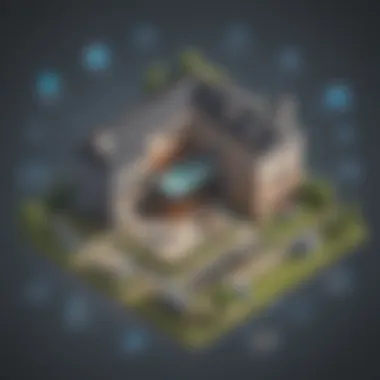Unraveling the Intricacies of Cisco's 'show neighbors' Command


Overview of the Cisco 'show neighbors' Command
In the realm of Cisco networking devices, the 'show neighbors' command stands as a crucial tool for network administrators and IT professionals. This command unveils a wealth of essential information concerning the immediate connections and relationships within a network infrastructure. Understanding the intricacies of this command is paramount for efficient network troubleshooting and maintenance. By delving into the specifics of the 'show neighbors' command, one can gain valuable insights into the network topology, device relationships, and potential points of failure. Mastery of this command empowers individuals to make informed decisions, optimize network performance, and enhance overall operational efficiency.
When executing the 'show neighbors' command on a Cisco device, a comprehensive report is generated, showcasing pertinent details such as device identifiers, IP addresses, interface information, connection types, and neighbor states. This comprehensive output provides a snapshot of the network at a particular moment, enabling administrators to identify potential issues, verify connections, and ensure network stability. By deciphering the data provided by this command, administrators can proactively address connectivity issues, detect unauthorized devices, and streamline network management processes.
Further exploration of the 'show neighbors' command allows individuals to detect any anomalies in the network, facilitate timely troubleshooting efforts, and prevent potential security breaches. In essence, mastering this command is synonymous with wielding a powerful instrument for network optimization, performance enhancement, and cybersecurity protection in the dynamic landscape of Cisco networking environments.
Introduction
To delve into the intricate workings of the Cisco 'show neighbors' command is to unravel the threads of networking efficiency and troubleshooting capabilities. In this article, we navigate through the depths of this command, shedding light on its significance and practical applications in the realm of network maintenance and optimization. By dissecting the 'show neighbors' command, we aim to equip network administrators and IT professionals with the knowledge and insights needed to expedite network issue resolution and strengthen overall network resilience.
Overview of 'show neighbors' Command
Definition and Functionality
At the core of the 'show neighbors' command lies its fundamental purpose - to unveil the connectivity landscape within a network infrastructure. This command acts as a pivotal tool in determining the relationships between devices, pinpointing potential bottlenecks, and facilitating swift responses to network irregularities. The defining trait of the 'show neighbors' command is its capability to provide real-time data on network topology, fostering informed decision-making in network management endeavors.
Importance in Network Troubleshooting
The 'show neighbors' command emerges as a beacon of light in the realm of network troubleshooting, offering a bird's eye view of network device interconnections. Its role in diagnosing network issues cannot be overstated, as it enables administrators to swiftly identify problematic areas and take timely corrective measures. The paramount significance of this command lies in its ability to streamline the troubleshooting process, minimizing network downtime and bolstering operational continuity.
Common Use Cases
Across diverse network environments, the 'show neighbors' command finds ubiquitous utility in various scenarios. From verifying inter-device links to evaluating network segmentation effectiveness, this command serves as a versatile asset in the arsenal of network administrators. Its common use cases span from routine network audits to troubleshooting complex connectivity issues, solidifying its status as a go-to resource for ensuring network robustness and functionality.
Target Audience
Network Administrators


Network administrators, the custodians of network integrity, stand as the primary beneficiaries of delving into the nuances of the 'show neighbors' command. By harnessing the insights offered by this command, administrators can proactively monitor network health, detect anomalies, and fortify network defenses against potential threats.
IT Professionals
For IT professionals immersed in the intricate tapestry of network architecture, a nuanced understanding of the 'show neighbors' command serves as a beacon of operational clarity. By leveraging this command, IT professionals can expedite network issue resolution, optimize network performance, and fortify network resilience to adapt to evolving technological landscapes.
Networking Enthusiasts
Networking enthusiasts, driven by an insatiable curiosity for all things network-related, discover a wealth of knowledge and practical application in mastering the 'show neighbors' command. By engaging with this command, enthusiasts can unravel the interconnected web of networking principles, deepen their understanding of network dynamics, and elevate their proficiency in network management practices.
Basics of 'show neighbors' Command
When delving into the 'Basics of the 'show neighbors' Command' in the landscape of this article, it becomes evident that understanding the foundational elements of this command is pivotal for network administrators and IT professionals. This section serves as the backbone for comprehending the intricate workings of the command in the context of Cisco networking devices. Exploring the syntax, structure, and fundamental principles underlying the 'show neighbors' command sets the stage for a profound grasp of its functionalities and applications in real-world network management scenarios.
Syntax and Structure
Command Format
In dissecting the 'Command Format' aspect, a key component of the syntax and structure of the 'show neighbors' command, we unravel the specific format requirements that shape the command's execution. The command format not only dictates how inputs should be structured but also influences the output generated by the command. By adhering to the prescribed command format guidelines, users can harness the full potential of the 'show neighbors' command, thereby streamlining network monitoring and troubleshooting processes effectively. The structured nature of the command format enhances efficiency, promotes standardization across network operations, and simplifies the interpretation of command output, contributing to a more seamless network management experience.
Options and Flags
Turning our attention to 'Options and Flags,' another critical facet of the syntax and structure of the 'show neighbors' command, we delve into the additional parameters that can be incorporated to customize command behavior. Options and flags provide users with versatility and control, allowing for tailored command execution based on specific requirements or objectives. By utilizing these options and flags judiciously, network administrators can fine-tune the command's functionality to extract precise information pertinent to network configuration, device connectivity, or troubleshooting needs. Understanding the nuances of available options and flags equips users with a toolbox to navigate diverse network scenarios, optimize command performance, and extract granular insights essential for informed decision-making within network management settings.
Understanding Output
Delving into the output generated by the 'show neighbors' command unveils a plethora of valuable information essential for network diagnostics and performance evaluation. Understanding how to decipher and extract insights from the output is imperative for deriving actionable intelligence and resolving network discrepancies effectively.
Meaning of Different Fields


When exploring the 'Meaning of Different Fields' within the command output, we unravel the significance attributed to each field and its contribution to painting a holistic picture of network connectivity. Each field within the output encapsulates critical data points that offer insights into device relationships, connectivity statuses, and network topology. By deciphering the meaning behind each field, users can gain a comprehensive understanding of network infrastructure, identify potential bottlenecks, and proactively address network anomalies to ensure optimal functionality and performance.
Interpreting Neighbor Information
Equally crucial is the skill of 'Interpreting Neighbor Information' gleaned from the command output. By deciphering neighbor information, users can map out network dependencies, assess device interconnections, and troubleshoot connectivity issues efficiently. Interpreting neighbor information enables network administrators to pinpoint root causes of network disruptions, enhance troubleshooting accuracy, and expedite issue resolution, fostering a robust and agile network environment primed for seamless operation and maximum efficiency.
Advanced Features
In this section, we delve into the advanced features of the 'show neighbors' command in Cisco networking devices. Understanding these features is crucial for network administrators, IT professionals, and networking enthusiasts looking to optimize their network management processes. By conducting a detailed analysis of the neighbor relationship status and interface details, users can gain valuable insights into their network infrastructure, leading to more efficient troubleshooting and network performance enhancement.
Detailed Analysis
Neighbor Relationship Status
The neighbor relationship status is a critical aspect of the 'show neighbors' command as it provides information on the connectivity status between networking devices. By examining this status, users can determine whether the connection between devices is established, pending, or encountering issues. This feature plays a pivotal role in network monitoring and troubleshooting, allowing administrators to identify potential connectivity issues promptly. Although the neighbor relationship status offers valuable insights, users must interpret this information accurately to address any connectivity problems effectively.
Interface Details
The interface details section of the 'show neighbors' command offers a comprehensive overview of the physical and logical interfaces of networking devices. Understanding interface details is essential for network administrators to assess the status of interfaces, including operational status, speed, and duplex settings. By analyzing interface details, users can pinpoint potential bottlenecks, errors, or misconfigurations within the network infrastructure. This feature helps ensure optimal network performance and seamless data transmission. However, users should exercise caution when interpreting interface details to avoid erroneous configuration changes that may impact network functionality.
Troubleshooting with 'show neighbors'
In this segment, we explore how the 'show neighbors' command can be a valuable tool for troubleshooting network connectivity issues and resolving network problems efficiently. By employing the command to identify connectivity issues and address network errors, users can streamline their troubleshooting processes and maintain network reliability.
Identifying Connectivity Issues
Identifying connectivity issues using the 'show neighbors' command enables users to pinpoint potential network bottlenecks, faulty connections, or configuration errors that may disrupt data flow. This functionality aids in isolating connectivity issues promptly, allowing administrators to take swift corrective actions to minimize network downtime. By leveraging this feature, users can enhance network stability and performance, ensuring uninterrupted data transmission across devices.
Resolving Network Problems


The 'show neighbors' command facilitates the resolution of network problems by providing detailed insights into device connectivity and configuration. By utilizing the command's output to troubleshoot network issues, users can expedite the resolution process and mitigate potential service disruptions. This feature is instrumental in maintaining network integrity and security, as it allows for swift identification and resolution of network anomalies. However, users should exercise caution when making configuration changes based on the command output to prevent inadvertent network errors or vulnerabilities.
Best Practices and Tips
In the world of networking, mastering the art of 'show neighbors' command in Cisco devices is crucial for efficient maintenance and troubleshooting. The section of Best Practices and Tips serves as a beacon for network administrators, providing essential guidelines to maximize the command's utility. By delving into the intricacies of command execution optimally and the significance of utilizing it correctly, professionals can enhance their network management capabilities drastically. Understanding the nuances of this command not only streamlines operations but also promotes a proactive approach towards network monitoring and issue resolution.
Optimizing Command Usage
Regular Monitoring
Regular Monitoring emerges as a cornerstone in the realm of network maintenance. It involves the consistent tracking of network activity and performance, allowing administrators to detect anomalies promptly and ensure optimal functioning. A key characteristic of Regular Monitoring lies in its proactive nature, enabling preemptive actions to prevent potential network disruptions. By regularly monitoring network data and equipment statuses, administrators can identify trends, anticipate issues, and maintain peak operational efficiency. The unique feature of Regular Monitoring lies in its ability to provide real-time insights into network health, empowering administrators to make informed decisions swiftly based on live data. While it demands time and resources, the long-term advantages of proactive network monitoring undoubtedly outweigh any initial challenges.
Documentation Practices
Documentation Practices play a pivotal role in ensuring effective network management. By meticulously documenting network configurations, changes, and incidents, administrators can create a comprehensive repository of network history and operations. The key characteristic of Documentation Practices is its focus on creating a reliable information source that aids in troubleshooting, planning, and decision-making processes. This disciplined approach not only streamlines collaborative efforts within IT teams but also enhances transparency and accountability. The unique feature of Documentation Practices lies in its ability to capture critical details that are instrumental in diagnosing network issues accurately and facilitating knowledge transfer within the organization. While it requires discipline and consistency, the benefits of maintaining detailed network documentation are invaluable in navigating complex network infrastructures.
Ensuring Network Security
Detecting Unauthorized Devices
Detecting Unauthorized Devices is paramount in safeguarding network integrity and data confidentiality. This practice involves deploying monitoring tools and techniques to identify and mitigate any unauthorized devices connected to the network. The key characteristic of Detecting Unauthorized Devices lies in its proactive stance against potential security breaches, minimizing vulnerabilities and unauthorized access points. By promptly detecting and addressing unauthorized devices, administrators can uphold network security standards and prevent malicious activities effectively. The unique feature of this practice lies in its capacity to detect rogue devices swiftly, enabling rapid responses to mitigate security risks. While it requires continuous vigilance and robust security protocols, the advantages of detecting unauthorized devices promptly far outweigh the risks posed by undetected intrusions.
Preventing Unauthorized Access
Preventing Unauthorized Access is imperative for fortifying network defenses and protecting sensitive information. This practice involves implementing stringent access controls, authentication mechanisms, and encryption protocols to restrict unauthorized entry into the network. The key characteristic of Preventing Unauthorized Access lies in its proactive approach to preempting security breaches, ensuring only authorized personnel can access network resources. By enforcing strict access policies and encryption standards, administrators can minimize the risk of data breaches and unauthorized information disclosure. The unique feature of this practice lies in its ability to maintain data integrity and confidentiality, mitigating the impact of potential security incidents. While it demands continuous monitoring and updates to stay ahead of evolving threats, the benefits of preventing unauthorized access are fundamental in maintaining a secure network environment.
Conclusion
Key Takeaways
Empowering Network Management
Exploring the aspect of network management empowerment within the realm of Cisco devices sheds light on how the 'show neighbors' command plays a pivotal role. Empowering network management through this command enables real-time monitoring of device connections, aiding in the detection of unauthorized devices and potential security breaches within the network. This proactive approach to network supervision enhances the overall security posture and operational efficiency of the network infrastructure.
Enhancing Network Efficiency
Enhancing network efficiency through the utilization of the 'show neighbors' command fosters proactive maintenance and optimized performance. By leveraging the detailed output provided by this command, network administrators can identify and rectify connectivity issues promptly, reducing downtime and optimizing network functionality. The enhanced network efficiency achieved through the strategic application of this command leads to improved user experience and overall network reliability, positioning the network for seamless operations and growth.





